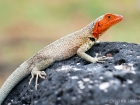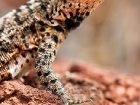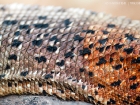Before I start preparing blog posts of the spectacular main reason to visit the Galápagos (you’re right, birds!) – I’ll show you photos of another fascinating group of animals, whose mostly huge members roam most of the islands of the archipelago.
Galápagos land iguana (Conolophus subcristatus) inhabits the islands of Fernandina, Isabela, Santa Cruz, Baltra, North Seymour and South Plaza. I had good opportunities to photograph them on the latter two. This mostly herbivorous species is thought to be (together with Galápagos giant tortoise) the evolutionary force to be responsible for the tall-growing prickly pear cacti. The iguanas feed on the cacti’s leaves, which the plant tries to avoid by developing trunks, often up to 10m high. Hence, the cacti are growing small and without trunks on islands without iguanas and tortoises.
Barrington Land Iguana (Conolophus subcristatus) is endemic to the 24 km² large island of Santa Fé.
Galápagos giant tortoise (Chelonoidis nigra) is one of only two species of giant tortoise alive (the other one being Aldabra giant tortoise from the Seychelles). There are several subspecies in the archipelago of which some went extinct during the exploitation of the islands by whalers, pirates and buccaneers. The last tragic episode being the extinction of Chelonoidis nigra abingdoni in June 2012, when well-known ‚Lonesome George‘ died in the in the Charles Darwin Research Station on Santa Cruz without a mate of the same subspecies.
Lava Lizards (Microlophus sp.) occur throughout the archipelago. There are nine species endemic to the Galápagos islands.
Marine Iguana (Amblyrhynchus cristatus) to my eyes is the most fascinating reptile of the Galápagos and one of the most outstanding in the world. This lizard is the only one to forage in the sea, being able to dive more than 15 m. The species is widespread and occurs in several subspecies, differing in size and color.











































